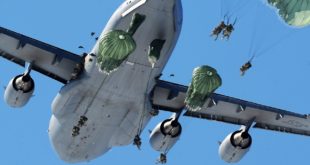Introduction: The exponential growth of space objects, including orbital debris, poses an increasing risk of collisions in Earth’s orbit. With over 100 million objects less than 1 cm in size, the safety of operational satellites is a significant concern. Any of debris objects can cause harm to an operational spacecraft, …
Read More »Advancing Electromagnetic Sensing: DARPA RFI Calls for Ultrasensitive High-Frequency (HF) Sensors for DOD Applications
Introduction: Electromagnetic sensors play a crucial role in various applications, ranging from communication systems and radar technology to medical imaging and security systems. In recent times, the Department of Defense (DoD) has shown a keen interest in pushing the boundaries of electromagnetic sensing capabilities, specifically in the high-frequency (HF) regime …
Read More »Mind Over Matter: The Latest Developments in Brain Control Interfaces for Military
New era has arrived when people use only their thoughts to control not only themselves, but the world around them. Every action our body performs begins with a thought, and with every thought comes an electrical signal. The electrical signals can be received by the Brain-Computer Interface (BCI), which can electroencephalograph …
Read More »Quantum Drum: Pioneering Precision Measurement Technology for Everyday Devices
In a quantum leap forward, researchers at the University of Copenhagen have unveiled a groundbreaking innovation: the “quantum drum.” This remarkable technology, capable of detecting pressure, heat, gas leaks, and even the shape of a single virus, has been adapted to operate at room temperature. Until now, the quantum drum’s …
Read More »Brain-to-Brain Communication on the Frontlines: The Emergence of Brain-to-Brain Interfaces for Soldiers
The brain-computer interface (BCI) allows people to use their thoughts to control not only themselves, but the world around them. Every action our body performs begins with a thought, and with every thought comes an electrical signal. The electrical signals can be received by the Brain-Computer Interface (BCI), consisting of …
Read More »DARPA NaPSAC developing novel in-memory computing architectures for modelling complex DOD systems
Scientific modeling is the process of creating simplified representations of complex phenomena in order to better understand them. Complex, multi-spatiotemporal, and nonlinear problems are particularly challenging to model because they involve multiple variables, interactions, and feedback loops that can be difficult to predict. Examples of such complex systems of relevance …
Read More »Transforming Military Parachutes: The Role of AI and Stealth in Safety and Effectiveness
A parachute is a device used to slow the motion of an object through an atmosphere by creating drag (or in the case of ram-air parachutes, aerodynamic lift). Parachutes are usually made out of light, strong fabric, originally silk, now most commonly nylon. They are typically dome-shaped, but vary, with …
Read More »Disrupting the Food Industry: The Rise of Food Technology Market
There is an urgent need for sustainable food production due to a number of challenges facing the global food system. Climate change is affecting food production by altering growing conditions, reducing crop yields, and increasing the risk of pests and diseases. Sustainable food production practices can help to reduce greenhouse …
Read More »Revolutionizing Military Tasks: How DARPA’s Perceptually-Enabled Task Guidance (PTG) Program is Developing AI Assistants to Partner with Military Personnel in Complex Environments
Introduction: In today’s military landscape, personnel face the challenge of performing increasingly complex tasks while interacting with sophisticated machines and platforms. To address this, DARPA launched the Perceptually-enabled Task Guidance (PTG) program in 2021, aimed at developing advanced AI technologies to provide real-time guidance and support to military personnel. By …
Read More »Growing Commercialization of Graphene, the wonder Nanomaterial
Nanotechnology is the field of science and engineering that deals with the design, production, and manipulation of materials and devices at the nanoscale. The nanoscale is defined as the size range between 1 and 100 nanometers, where one nanometer is one billionth of a meter. At this scale, materials and …
Read More » International Defense Security & Technology Your trusted Source for News, Research and Analysis
International Defense Security & Technology Your trusted Source for News, Research and Analysis



